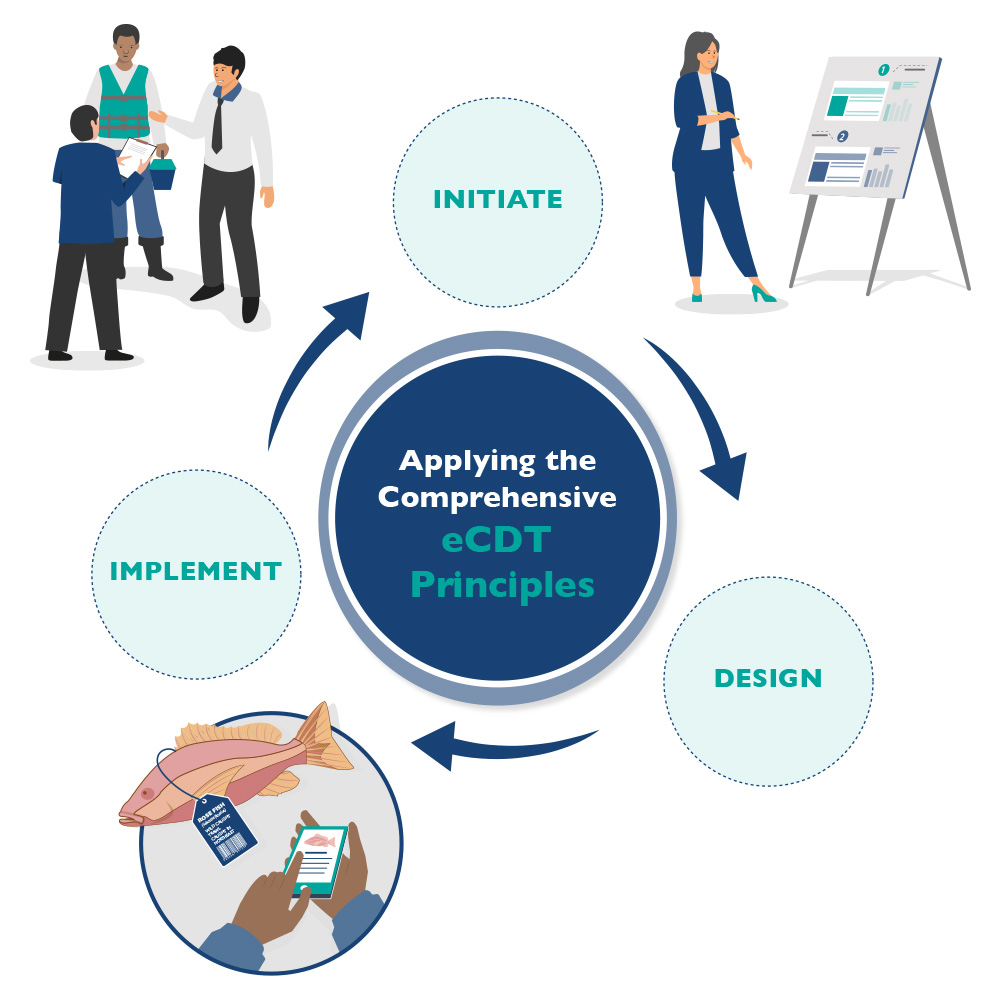Comprehensive Traceability Principles
Pathway to the Principles

The Pathway to the Principles details ways to apply the Principles when administering or improving a comprehensive electronic catch documentation and traceability (eCDT) program. These actions can be taken in a step-by-step approach if you are designing a program from scratch, or you can choose which actions are most relevant to your program needs. A seafood traceability program that is comprehensive means it uses captured data to realize three potential benefits: ecological, social, and economic. Three phases (Initiate, Design, and Implement) guide users (governments, industry, NGO implementers, or traceability consultants) through a series of potential actions toward a comprehensive eCDT program.
Featured at the left of each activity is the icon matching one of the six relevant Principles. Clicking on any of the actions will reveal more information and examples of relevant guidance to support application.
If you’re curious about how the Principles and Pathway were applied in a seafood producing country, learn how this guidance was put into action for a small-scale octopus fishery in Tanzania.
Principles Key
- In consultation with stakeholders, clearly define objectives (across ecological, social, and economic dimensions) of the comprehensive eCDT program, and how data will be used to drive change (i.e., through data utilization, verification, and transparency in how data is used).
Relevant Guidance
- Consider who will pay to set up and maintain the system; what market incentives may or may not be in place; and the ability to influence or leverage political will.
- Determine if the budget for the program is secure and where political support is strongest and weakest.
Relevant Guidance
- Review past eCDT programs and lessons learned to avoid common pitfalls; consider reviewing recommendations from traceability programs outside of seafood.
- Consult relevant on-the-ground NGOs and/or technology consultants that can support peer reviews and peer-learning efforts.
Relevant Guidance
- Identify and assess existing support for a comprehensive eCDT program (i.e., infrastructure, data and data systems architecture, regulatory enforcement measures, interested institutions, relevant private sector initiatives).
- Assess stakeholder and institutional perceptions of the potential of an entirely new program, including its socioeconomic impacts (cost of developing, adopting, using, etc.) to mitigate unintended consequences such as negative environmental or human rights impacts.
- Analyze the potential impact of an eCDT program on different genders and other key stakeholder demographics.
- Leverage existing or encourage creation of supportive partnerships between governments and businesses in order for both groups to best fulfill their complementary roles as outlined in the UN Guiding Principles.
- Check for norms, policies, and government enforcement regarding health and safety, core human rights principles (i.e., the ILO core conventions, engagement with national or global trade unions), and worker voice that enables effective grievance mechanisms without retaliation, while protecting worker confidentiality, promoting decent work, and upholding fundamental human and labor rights.
Relevant Guidance
- Conduct a general overview of involved fisheries, including current catch documentation, reporting, and social responsibility data collection practices across government agencies to understand data needs.
- Facilitate data mapping (when technology systems are able to exchange information or data seamlessly) by identifying labor and product data requirements already in place in key markets and across relevant agencies (e.g., import rules, food safety).
- Identify any standardized data formats that would be relevant to the goals of the program (e.g., GDST KDEs).
Relevant Guidance
- Assess existing exposures and risks of illegal, unreported, and unregulated fishing (IUUF) for relevant stocks and supply chains within the eCDT program, including mechanisms to mitigate for any identified risks, if any.
- Specify areas of risk and what practices are needed to remediate identified issues (e.g., port controls, third-party data verification, vessel audits, capacity building with supply chain actors, etc.).
- Identify related governing agencies or departments responsible for acting on data or process improvement needs and barriers that may be associated if governing agencies choose not to participate in the eCDT program.
- Assess exposures and risks of human rights abuse for people working in or associated with relevant stocks and supply chains, including enabling mechanisms to strengthen policy for labor protections (such as the right to freely associate and collectively bargain), and/or general social safeguards (such as protections for free speech) and human rights defenders.
- Specify existing risk data sources and needs, including time spent at sea, captain’s logs, or instances of at-sea transshipment, recruitment dynamics, and risks to fishers’ families.
- Identify related civil society organizations, worker associations including trade unions, governing agencies, or departments (such as departments of labor or employment) that work on human rights risk, abuse, policy, and/or data collection.
Relevant Guidance
- Collect baseline data of costs involved with current fisheries management program, including food safety and regulatory compliance.
- Set expectations around a feasible long-term return on investment, as financial returns may take time to manifest.
Relevant Guidance
- Properly identify relevant stakeholders from governments, affected fisheries (including small-scale), technology/service providers, supply chain companies, trade unions, multi-stakeholder collaborations, and other worker/labor groups, depending on the level (international, national, regional, or company) on which you aim to develop an eCDT program to meet those stakeholders’ needs.
- Identify whether the program will impact marginalized and disenfranchised stakeholders (including migrant workers and women) and take steps to build trust and include them.
Relevant Guidance
- Identify and clarify the value proposition of eCDT in collaboration with program users (businesses, quality assurance and compliance agencies, scientists, workers, etc.).
- Be transparent with stakeholders about the potential benefits of the program that have been demonstrated in other programs, the intended scope of the program, and the degree to which there is flexibility to modify implementation when benefits are not being realized.
Relevant Guidance
- Identify the preferred form of communication for stakeholder groups involved in program design, and ensure equitable inclusion for marginalized and disenfranchised groups, which will depend on scope, objectives, and fishery characteristics.
- Integrate knowledge and build accountability and trust using stakeholders’ preferred outreach and method; use the local language and an accessible format, considering user needs, cultural considerations, and groups that may be disproportionately impacted by eCDT implementation.
- Consider power dynamics and relationships among stakeholders in the consultation process (e.g., workers and businesses, gender, government and private sector).
- Use transparent and participatory decision-making processes.
- Include trade unions and civil society members in governance structures to support long-term social dialogue.
- Ensure that feedback from stakeholders is incorporated throughout the entire project life cycle to improve the program as it evolves.
Relevant Guidance
- Define the minimum data required to meet program objectives.
- Identify where more information is needed to define data/technology needs.
- Map key data elements (KDEs) to critical tracking events (CTEs) within affected supply chains.
- Identify where CTEs start and end given the different jurisdictions among different players (e.g., regulators, stakeholders, regional bodies, etc.).
- Identify where duplicative information is being requested and work with relevant stakeholders to align requests for efficiency.
- Minimize exemptions granted from eCDT program data collection, but state clearly where they do exist (e.g., small-scale fishers, certain vessel types, instances in which data collection on workers may be used against them).
Relevant Guidance
- Create a data quality assurance protocol that includes data and process verification.
- Identify how and where data will be verified to support accuracy and program compliance.
- Consider contracting external consultants to conduct third-party data audits to increase trust among practitioners and reinforce validity of decision-making processes.
Relevant Guidance
- Clearly define who has access to data and for what purpose, with special consideration for worker privacy.
- Prioritize informed consent and participant access to data.
Relevant Guidance
- Select supply chains that are well understood and sites that have on-the-ground (industry and NGO) support.
- Leverage (or build on) existing or previous seafood traceability pilots in the area of interest, when possible, to prevent duplicative efforts and encourage efficient use of resources.
Relevant Guidance
- Identify differences between the proposed program and the existing national strategy for fisheries management.
- Consider those who may not have had input in the design of the existing program, and how their perspectives might have changed the design.
- Align data collection with stock assessment and/or integrate with existing fisheries management plans to ensure sustainable fishery management and promote biodiversity conservation.
Relevant Guidance
- Identify governing agencies with jurisdiction over data related to worker welfare and data security issues (e.g., departments of labor and/or employment) and enforcement of minimum wage, immigration status, and health care requirements to increase the relevance, incorporation, and interoperability of any social data collected by the eCDT program.
- Identify existing protocols for how to share social data with agencies that oversee worker information, and revise or create new protocols as needed to improve worker welfare outcomes.
Relevant Guidance
- Consult existing data privacy laws, and identify processes, accountability mechanisms, or new schemes for responding to privacy considerations and stakeholder/user concerns as needed.
- Ensure that personally identifiable information is redacted from publicly shared data.
- Confirm that fishers and other workers have access to confidential grievance and remedy systems.
- See definitions for grievance mechanisms and remedy in the Glossary for Comprehensive Principles.
- Connect program implementers and stakeholders in other rights monitoring, advocacy, and social support organizations and systems (e.g., trade unions, migrant advocacy organizations, human rights advocates) to contextualize risks for workers.
- Consider civil society organizations that can support workers and program implementers in upholding key human rights needs (e.g., grievance and remedy) by helping uphold workers’ rights, which often requires specialized skills and experience.
Relevant Guidance
- Require only the minimum technology adoption and data collection needed to meet program objectives.
- Identify technology that adds value to businesses’ bottom line; ensure there is a built-in cost-recovery scheme.
Relevant Guidance
- Ensure that the program is compatible with the traceability requirements of major importers like the United States, the European Union, and Japan.
- Consult trade monitoring organizations (e.g., WTO) to avoid creating trade barriers.
Relevant Guidance
- Identify expertise and capacity of stakeholders and leverage expertise.
- Acknowledge that implementation roles and responsibilities for eCDT programs will vary across nations (e.g., flag, coastal, port, processing, end market).
- Acknowledge that financial or capacity support may differ between developed and developing nations.
- Define roles and capacity of private sector and government bodies, especially within government agencies implementing the Principles including labor, employment, and food safety. (Who will cover the costs? Who will collect or verify the data? Will the development process involve partnerships between government and industry?)
- Identify groups that can contribute to identifying worker roles, responsibilities, and needs (e.g., worker committees, fisher cooperatives, trade unions, other civil society organizations).
- Outline role of individuals or companies collecting, verifying, and submitting data.
- Identify opportunities for stakeholders—particularly civil society organizations and regional entities—to provide oversight of the program and governance structures.
Relevant Guidance
- Explicitly identify the responsibilities and authorities of each agency as they pertain to the goals of the comprehensive eCDT program.
- Consider data sharing agreements (DSA), formal contracts clearly documenting what data is being collected and shared and how it can be used, by whom, and for what purposes.
- Determine how to best integrate processes of various involved agencies for efficacy of the program.
- Determine whether agencies require technical assistance or capacity building to construct the data management system, and if so, how they can obtain that assistance.
Relevant Guidance
- Obtain both commitment and action (implementation, monitoring, control, and enforcement) along entire supply chains to derive counter-IUU fishing and worker protection benefits.
- Recruit influencers to support program adoption (community leaders, association heads, industry champions, thought leaders, key local government officials) and to test the program.
Relevant Guidance
- Let data collection, program objectives, and user needs drive eCDT tool selection, not the promised functions of the technology itself.
- Define the architecture of the system (e.g., central repository, distributed ledger, etc.).
- Ensure that the program is vendor-neutral, where appropriate, and that transparency mechanisms (public requests for proposals, for example) are mandatory when competing for government contracts.
Relevant Guidance
- Use site-specific approaches or designs where possible, though customization should support interoperability.
- Consult with technology users before and during implementation (see “Initiate” section).
- Use co-creation to develop the program, since it can foster buy-in and ownership among users.
Relevant Guidance
- Build on existing and planned investments.
- Use standardized data formats (i.e., key data elements (KDEs)).
- Consider alignment with industry data standards (e.g., GDST Standards & Materials) and import data requirements of market states (e.g., U.S. SIMP).
- Allow national electronic traceability platforms, where they exist, to interface with eCDT systems, including private sector systems.
Relevant Guidance
- Encourage policy adoption/development that aligns with international data standards and import regulations to strengthen eCDT support at the governmental level.
- Advocate for government ratification and implementation of international agreements that standardize expectations for workers’ rights.
- Encourage buyer traceability systems and policies to integrate into program protocols by engaging with supply chain partners, verifying sustainability claims, implementing interoperable systems, etc.
- Generate community support for the program where possible.
Relevant Guidance
- Plan for long-term funding to support all steps of program implementation (e.g., IT services, enforcement, interagency coordination, outreach, infrastructure support, monitoring, etc.).
Relevant Guidance
- Build in designated periods for monitoring and adaptation, particularly from the entities providing oversight.
- Design the program for modern and emerging technology in data analytics.
- Avoid prescribing a specific technology so that the program can adapt to changes.
Relevant Guidance
- Formalize partnership with those who will be the first implementers.
- Identify and address barriers and challenges to technology adoption.
- Implement mechanism to receive and integrate feedback from the first implementers.
- Ensure data security is maintained.
Relevant Guidance
- Provide training to stakeholders across the supply chain.
- Encourage uptake of the program with training and support including maintenance or analysis and interpretation of data collected.
- Include training of community engagement practitioners to ensure information is safeguarded and aggregated.
- Use culturally effective methods of communication and ensure instructions are available in useful formats.
- Consult with stakeholders to gather feedback.
Relevant Guidance
- Measure economic and non-economic effects of eCDT program, such as improved/standardized product prices, increased engagement of women in the fisheries supply chain, and communal improvements made with the additional income generated by the use of eCDT.
Relevant Guidance
- Conduct cost-benefit analysis and/or a return-on-investment (ROI) study using collected baseline economic data.
- Consider conducting a socioeconomic impact study for government initiatives to advocate for sustained funding from state budgets.
- Identify other business and industry drivers (facilitation, trade preference, operational efficiencies, market state demands).
- Consider documenting and publicly reporting environmental, social, and ecological benefits.
Relevant Guidance
- Ensure and facilitate worker participation in program creation and implementation.
- Track and resolve concerns raised from workers regarding program efficacy and privacy.
- Monitor, evaluate, and adapt as needed.
- Evaluate the alignment and complementarity (as well as any gaps) in the roles of eCDT implementers and governmental agencies that monitor labor.
- Continue to strengthen dialogue between fisheries operators and labor monitoring agencies to confirm that the data gathered is used for implementation and/or enforcement of human rights laws and other social benefits
Relevant Guidance
- Ensure necessary agencies have clear data flows for assessing efficacy of ecosystem-based fisheries management (EBFM).
Relevant Guidance
- Adapt and scale technology and program protocols based on user feedback.
Relevant Guidance
- Know who is responsible for financially supporting and maintaining the system; whether market incentives are sustainable; and if political will maintained.
Relevant Guidance
- Determine how objectives of the scaled program overlap and differ from that of the pilot.
- Assess resources for scaling: are the funds, staff, infrastructure, political will, and resource commitments still present and appropriate for the scope of the project.
Relevant Guidance
- Acknowledge that program data needs, technology platforms, and users or beneficiaries are likely to evolve with changes in industry best practices, technology advances, market pressures, and availability of human and welfare data guidance.
- Adapt program over time to meet new regulatory, social, economic, and ecological needs.



